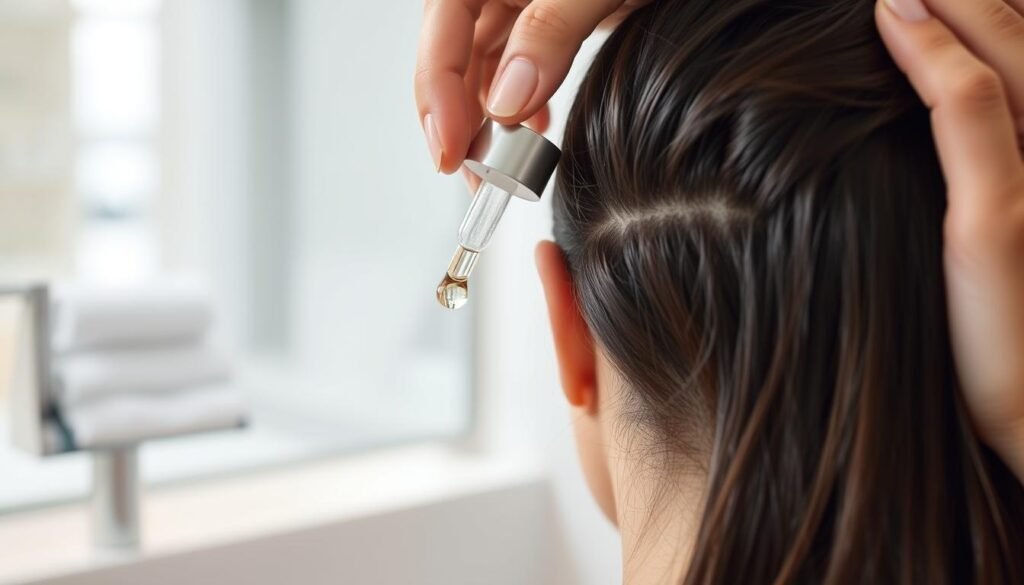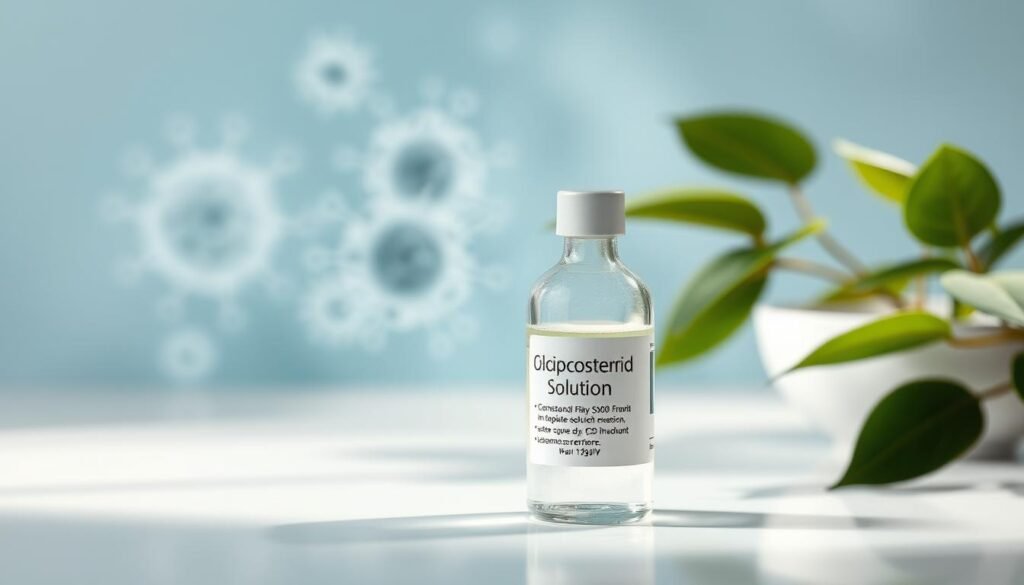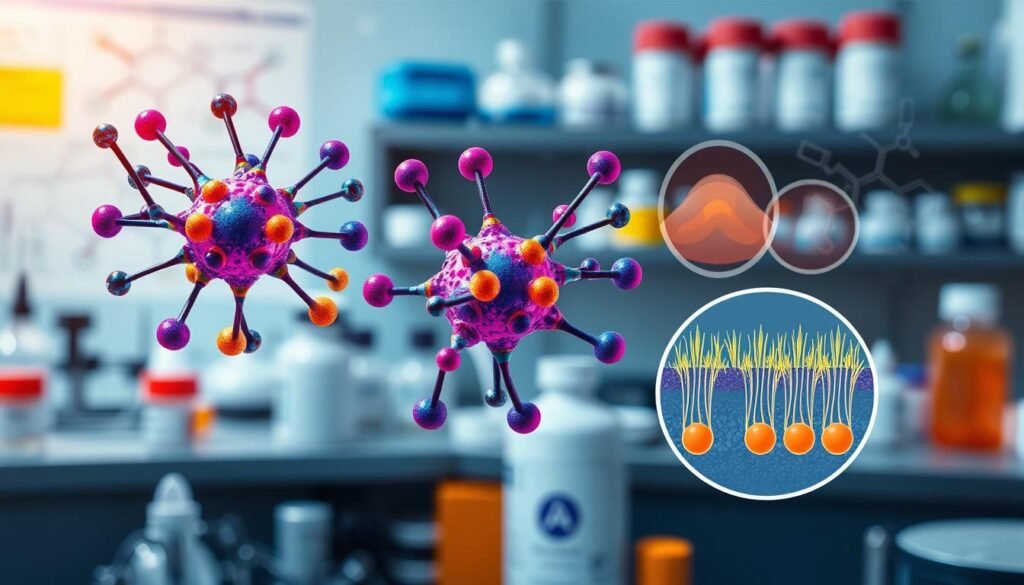Did you know about 80 million Americans face hair loss? It’s not just about looks; it also hits hard mentally. With many drugs out there for treatment, navigating alopecia medications is key for those looking for answers.
Alopecia stands out due to its unique aspects. It requires specific treatment methods. The journey to find effective therapies is important. This is because hair loss can affect one’s mind too. As medical experts continue to find new ways, knowing your options helps boost confidence and care for oneself.
Key Takeaways
- Pharmaceutical treatments for alopecia are varied and tailored to individual needs.
- About 80 million Americans experience hair loss, emphasizing the importance of effective solutions.
- Alopecia has psychological impacts, making personalized care crucial.
- Diverse types of alopecia require different approaches to treatment.
- Modern medicine offers innovative options for those affected by hair loss.
Understanding Alopecia and Its Types
Alopecia is hair loss for various reasons, like genes, the environment, and health problems. Knowing what Definition of Alopecia means is key to understanding its effect on people.
Definition of Alopecia
Definition of Alopecia is losing hair on your head or body. This loss isn’t just because of genetics. It could be from autoimmune issues, hormonal shifts, or big stress events. Each kind of alopecia looks different and has its own challenges.
Types of Alopecia
It’s crucial to know the different Types of Alopecia to diagnose and treat it right. Here are some common types:
- Alopecia Areata: This autoimmune condition causes unexpected hair loss in patches.
- Androgenetic Alopecia: Known as male or female pattern baldness, it’s based on genes and hormones.
- Telogen Effluvium: Stress or hormonal shifts can cause this temporary thinning.
More people learning about Types of Alopecia means better and quicker treatments. Each type needs a different approach to manage it effectively.
Overview of Hair Loss Medications
Understanding hair loss medications is key for those dealing with alopecia. There are prescription medications and over-the-counter treatments available. Each type has its own benefits, depending on what you need.
Prescription vs Over-the-Counter
Prescription meds like Finasteride and Minoxidil need a doctor’s okay. They are proven to work well for many users. But, over-the-counter options are easier to get. However, they might not work as well. These include Minoxidil solutions and hair growth shampoos.
Understanding Efficacy Rates
The success rates of hair loss treatments vary. Research shows Finasteride works for over 80% of men. Minoxidil is effective for about 60% of its users. But, over-the-counter products may be less effective. This is because of how they are made. How long you use them and your type of hair loss also play a part.
Pharmaceutical Treatments for Alopecia
Alopecia affects your feelings and how you see yourself. There are many treatments out there for it. They usually are either something you rub onto your scalp, or pills you take.
Topical Treatments
Minoxidil is a common treatment for hair loss. It helps more blood reach your scalp, which can make hair grow back. You need to put it on your head the right way, twice a day, for the best results. You might get an itchy scalp or hair where you don’t want it.
Oral Medications
Another way to tackle hair loss is by taking pills, like Finasteride for guys. It stops a certain hormone that makes hair thin out. You should take it as your doctor says. There could be some side effects like feeling less interested in sex, so talk to your doctor.
Using both pills and topical treatments might work best. Check out Ageless Glimmer for more on fighting hair loss.
| Treatment Type | Example | Mechanism | Application Frequency |
|---|---|---|---|
| Topical Treatments | Minoxidil | Promotes blood flow to hair follicles | Twice daily |
| Oral Medications | Finasteride | Inhibits DHT production | Once daily |
The Role of Minoxidil in Hair Regrowth
Minoxidil is key in helping people grow their hair back when facing alopecia. It boosts blood flow to the hair roots by dilating vessels. This action leads to more nutrients reaching the hair, possibly kick-starting hair growth.
How Minoxidil Works
Minoxidil widens blood vessels in the scalp. This action boosts nutrient flow, important for growing healthy hair. Studies suggest it can make hair thicker and denser by awakening hair follicles.
The medicine’s effects help improve hair regrowth significantly. That’s why it’s often suggested for those losing their hair.
Application Guidelines and Usage
For best results with Minoxidil, follow these steps:
- Apply it regularly on a dry and clean scalp.
- Typically, you should use 1 mL twice daily on the area losing hair.
- Don’t wash your hair or scalp for 4 hours post-application, ensuring it’s fully absorbed.
- If you get scalp irritation, try the foam type. Studies show it might work better for some people.
For those looking to boost their hair growth, reading studies on Minoxidil is helpful. Check out this research for insights. It discusses how Minoxidil affects hair growth over the long term.

Finasteride: A Popular Option for Men
Finasteride is a top choice for men losing hair. It’s known for its effectiveness in treating Alopecia Treatment for Men. The drug targets DHT, a hormone linked to hair loss. Knowing how it works is key for those considering it.
Mechanism of Action
Finasteride works by stopping testosterone from turning into DHT. This action cuts down on DHT and helps prevent more hair loss. Studies back up its success, showing that it can help grow hair back for many men.
Potential Side Effects
However, there are some potential Side Effects of Finasteride to think about. Issues like sexual problems, mood swings, and liver effects can happen. It’s important for users to balance these cons with the pros. Talking regularly with a doctor is crucial for handling any side effects.
For a deeper look into finasteride, including more uses, check this resource. It’s vital to understand both how it works and its side effects. This ensures patients make smart decisions in fighting hair loss.
| Consideration | Details |
|---|---|
| Efficacy | Promotes hair regrowth and prevents further loss in many cases. |
| Mechanism | Inhibits 5-alpha reductase to lower DHT levels. |
| Common Side Effects | Sexual dysfunction, mood fluctuations, liver function impact. |
| Consultation | Regular discussions with a healthcare provider recommended. |
Corticosteroids for Alopecia Areata
Corticosteroids are key in treating Alopecia Areata. They work by fighting inflammation and helping hair grow back. They reduce the immune attack on hair, giving hope to those affected.
How Corticosteroids Help
The body’s immune system attacks hair follicles in Alopecia Areata. Corticosteroids lower this immune response and inflammation. This improves hair growth and can slow hair loss. Their success varies by person, affected by the condition’s severity and length.
Methods of Administration
There are several ways to use corticosteroids, each with its pros and cons. The most common methods include:
- Injectable Corticosteroids: Direct injections into the scalp can give quick and strong results.
- Topical Corticosteroids: Creams and ointments are an easy option if you’re scared of needles.
- Oral Corticosteroids: Pills are used for severe cases, but long-term use can have side effects.
Choosing the best method depends on how bad the alopecia is and what the patient prefers. A healthcare pro can help make the right choice.

Exploring Immunotherapy as a Treatment
Immunotherapy is becoming a key player in fighting hair loss, especially Alopecia Areata. It works by adjusting our immune system. This can help bring back hair growth for those dealing with this issue.
What is Immunotherapy?
Immunotherapy boosts our immune system to fight diseases, including autoimmune ones like Alopecia Areata. Instead of focusing on the hair follicles, it changes how our immune response deals with hair loss. It may use creams or shots to help our body support hair follicles better.
Effectiveness in Alopecia Areata
The success of immunotherapy in treating Alopecia Areata differs from person to person. Many studies show it can lead to a lot of hair growing back. A review of trials found many patients see real improvements in hair thickness and overall look.
| Study | Number of Patients | Response Rate | Average Time to Regrowth |
|---|---|---|---|
| Study A | 50 | 70% | 12 weeks |
| Study B | 30 | 60% | 16 weeks |
| Study C | 100 | 75% | 10 weeks |
This table highlights how well immunotherapy works for Alopecia Areata. With ongoing research, we’ll better understand and improve this treatment. This could lead to new breakthroughs in hair loss therapy.
Innovative Options: JAK Inhibitors
Recent advancements have spotlighted JAK inhibitors as exciting new players in hair regrowth. They block enzymes essential in the inflammation causing hair loss. This is especially true for conditions like alopecia areata. They target the pathways hurting hair follicles.
What are JAK Inhibitors?
JAK inhibitors stop Janus kinases enzymes, crucial in immune system signals. By doing this, they reduce inflammation and encourage hair to grow back. They’re seeing success in treating different hair loss types, showing a big leap in alopecia treatments.
Current Research and Findings
Research into JAK inhibitors is promising. Oral drugs like baricitinib and ruxolitinib show great improvement over placebos in alopecia areata cases. This suggests they’re a solid choice for fighting hair loss. Scientists are now focusing on finding the best doses and understanding their long-term success. For more on this research, see the study here.

Platelet-Rich Plasma Therapy: A Growing Trend
Platelet-Rich Plasma Therapy is a new choice for fighting hair loss. It uses your body’s healing powers to grow hair. By concentrating platelets from your blood, it stimulates hair to regrow. This approach is gaining traction in hair restoration.
How PRP Treatment Works
The therapy starts with taking a little bit of your blood. This blood is spun in a machine to separate the platelets. Then, these platelets, packed with growth factors, are injected into your scalp. They go right to the hair roots to help new hairs grow and old ones get stronger.
Benefits and Considerations
PRP therapy is known for its perks. It’s a simple, non-surgical way to address hair loss. After the treatment, you won’t have to take much time off. You’ll see results that look natural and blend with your existing hair.
But, it’s good to know a few things before jumping in. The cost can change depending on where you go and the clinic you choose. You might also need more than one treatment to see the best results. Talk with your doctor to figure out the right plan for you.
| Aspect | Details |
|---|---|
| Procedure Type | Minimally Invasive |
| Recovery Time | Minimal Downtime |
| Results | Natural Hair Regrowth |
| Average Cost per Session | $1,500 – $3,000 |
| Recommended Sessions | 3 to 6 sessions for optimal results |
Conclusion
This article talked about different treatments for alopecia. It covered everything from common choices like minoxidil and finasteride to new ones like JAK inhibitors. Understanding these options is key for anyone trying to deal with hair loss.
Talking to medical experts is a must to find the right treatment plan. They can offer insights and tailor a plan for each person’s needs. Also, research into hair loss treatments is moving forward, giving new hope to those with alopecia.
It’s important to keep up with the latest in hair loss treatments, like the updates found in the summary of alopecia treatments. With new research and innovations, there are better options and hope for effective treatments soon.